Detailed Overview: Pronouns | English Grammar Basic - Class 10 PDF Download
What Are Pronouns?
You use pronouns every day. In fact, even if you don’t know what pronouns are, you use them—and in this sentence alone, we’ve now used pronouns four times.
- Pronouns are the words you substitute for other nouns when your reader or listener already knows which nouns you’re referring to.
- For example, you might say, “I have a dog. He’s brown and white. "
- There’s no need to clarify that you’re describing your dog in the second sentence because you already mentioned him in the first.
- But following up “I have a dog” with “brown and white” is grammatically incorrect . . . so with the pronoun “he’s,” you turn the phrase “brown and white” into a full sentence: He’s brown and white.
Pronouns do a whole lot more than turn phrases into sentences. They provide context, make your sentences’ meanings clearer, and shape how we perceive people and things.
Read on to learn about the different ways we use pronouns and how to use them to construct sentences. Pronouns are short words we swap in for other nouns to make our writing and speech faster and more varied. They’re words like:
- They
- I
- You
- Who
- Themselves
- Each other
Pronouns make up a small subcategory of nouns. The distinguishing characteristic of pronouns is that they can be substituted for other nouns.

For instance, if you’re telling a story about your sister Sarah, the story will begin to sound repetitive if you keep repeating “Sarah” over and over again.
For example:
- Sarah has always loved fashion. Sarah announced that Sarah wants to go to fashion school.
You could try to mix it up by sometimes referring to Sarah as “my sister,” but then it sounds like you’re referring to two different people:
- Sarah has always loved fashion. My sister announced that Sarah wants to go to fashion school.
Instead, you can use the pronouns she and her to refer to Sarah:
- Sarah has always loved fashion. She announced that she wants to go to fashion school.
Pronouns can replace both proper and common nouns. Certain pronouns have specific rules about when they can be used, such as how they should never be used to refer to a human being.
We will explain all of the different types and their associated rules below:
Types of Pronouns
1. Personal Pronouns
- A personal pronoun is a monosyllabic word that is used as a substitute for a proper noun that repeats itself in a particular context.
- A personal pronoun indicates the number and gender of the corresponding noun.
In grammatical sense, a personal pronoun is a pronoun that is related mainly to a particular person. Personal pronouns are not limited to people, it can also refer to animals and objects.
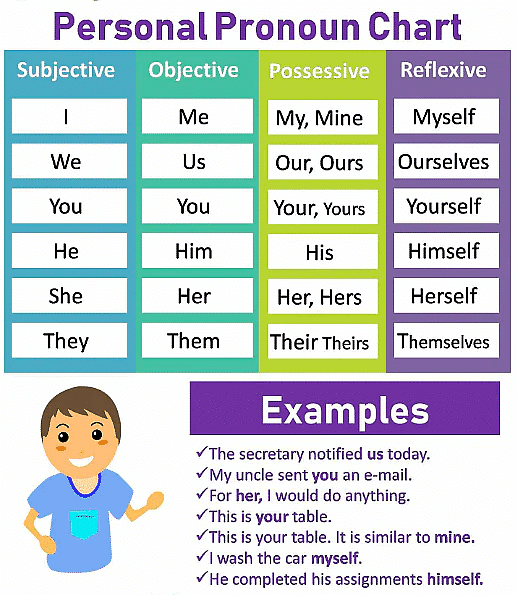
When you think of pronouns, you most likely think of personal pronouns. Personal pronouns are pronouns that refer to specific individuals and groups.
Personal pronouns include:
- I/me
- She/her
- He/him
- They/them
- We/us
- You
Here are a few examples of personal pronouns in italics, with the nouns they’re referring to bolded:
- The new student will arrive today. They will need a seating assignment and a name tag.
- My family loves nachos. We make them every Friday for movie night.
In the second example sentence, notice that nachos (a noun) and them (a pronoun) aren’t emphasized. That’s because in this sentence, them isn’t a personal pronoun because it isn’t replacing a proper noun, but rather we is.
2. Relative Pronouns
- A relative pronoun is a word that is used to connect an independent clause to a dependent clause.
- Relative pronouns are meant to provide more information about the subject (noun or pronoun) it relates to.
- These relative pronouns function exactly like adjectives, and so they can also be called adjective clauses.
- Relative pronouns include these words:
- that
- what
- which
- who
- whom
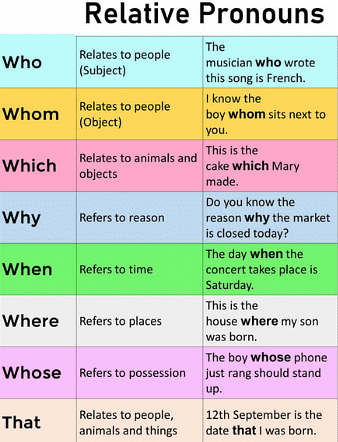
Traditionally, who refers to people, and which and that refer to animals or things. Here are a few examples of relative pronouns at work:
- The woman who called earlier didn’t leave a message.
- All the dogs that got adopted today will be loved.
- My car, which is nearly twenty years old, still runs well.
Who vs. Whom—Subject and Object Pronouns
- Knowing when to use who and when to use whom trips a lot of writers up.
- The difference is actually pretty simple: Who is for the subject of a sentence, and whom is for the object of a verb or preposition. Here’s a quick example:
- Who mailed this package?
- To whom was this package sent?
- See the difference?
- Who is a subject pronoun. It’s in the same category as I, he, she, they, and we.
- Whom is an object pronoun, which puts it in the same category as me, him, her, them, and us.
- An easy way to determine whether you should use who or whom in a sentence is to answer the sentence’s question by substituting another pronoun.
- With the new pronoun in place, determine if the sentence still makes sense.
- For example:
- He mailed this package.
- The package was sent to him.
- Figuring out when to use whom can be more difficult than knowing when to use who because it typically comes before the sentence’s verb—notice how the example object pronoun sentence changed more dramatically than the subject pronoun sentence.
3. Demonstrative Pronouns
Everyone might be familiar with the word ‘demo’: - The word demo is most commonly used as an acronym for demonstration.
- Demonstration means to indicate, identify, point out, exhibit or explain something to someone.
- A demonstrative pronoun is used to do the same thing. It demonstrates or represents the nouns that act as the subject or object in a sentence.
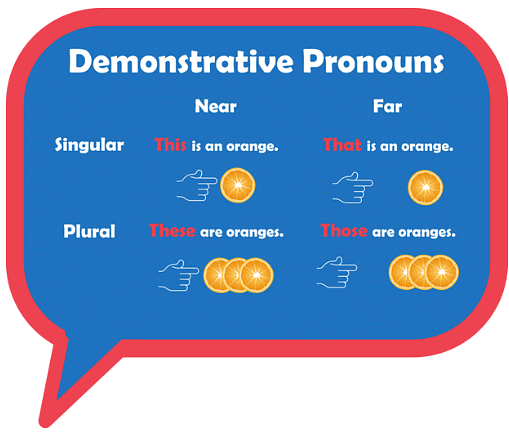
- That, this, these, and those are demonstrative pronouns.
- They take the place of a noun or noun phrase that has already been mentioned or is clear through context, either in written or verbal communication.
- This is used for singular items that are nearby. These is used for multiple items that are nearby. The distance can be physical or metaphorical.
Take a look at these examples:
- Here is a letter with no return address. Who could have sent this?
- What a fantastic idea! This is the best thing I’ve heard all day.
- If you think gardenias smell nice, try smelling these.
- That is used for singular items that are far away. Those is used for multiple items that are far away. Again, the distance can be physical or metaphorical.
Here are a few examples of these pronouns in action:
- A house like that would be a nice place to live.
- Some new flavors of soda came in last week. Why don’t you try some of those?
- Those aren’t swans, they’re geese.
4. Indefinite Pronouns
- Indefinite pronouns are used when you need to refer to a person or thing that doesn’t need to be specifically identified.
- Some common indefinite pronouns are one, other, none, some, anybody, everybody, and no one.
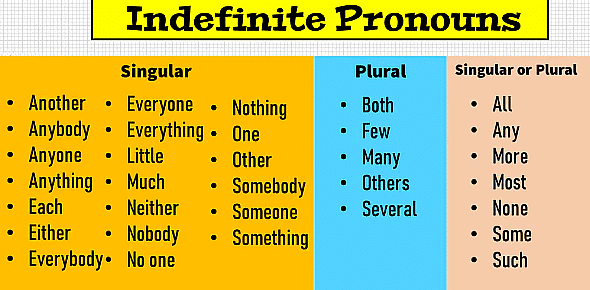
Here are a few examples of indefinite pronouns in sentences:
- Everybody was late to work because of the traffic jam.
- It matters more to some than others.
- Nobody knows the trouble I’ve seen.
When indefinite pronouns function as subjects of a sentence or clause, they usually take singular verbs.
5. Reflexive Pronouns
Reflexive pronouns end in -self or -selves:
- Myself
- Yourself
- Himself
- Herself
- Itself
- Oneself
- Ourselves
- Yourselves
- Themselves
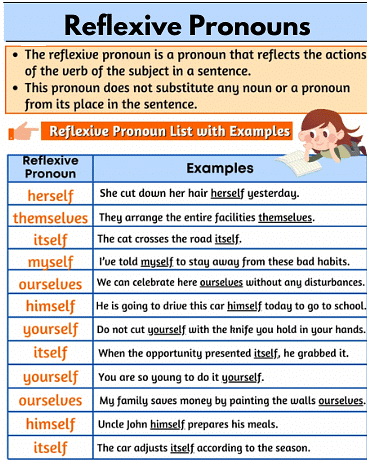
Use a reflexive pronoun when both the subject and object of a verb refer to the same person or thing.
Here are a few examples:
- She checked herself out of the hotel thirty minutes before check-out time.
- Take care of yourselves.
- Using myself when you mean me is a common mistake writers and speakers make.
- Reflexive pronouns are only correct when the subject and object of a sentence are the same.
6. Intensive Pronouns
- Intensive pronouns look the same as reflexive pronouns, but their purpose is different. Intensive pronouns add emphasis.
- Conceptualizing the difference between them and reflexive pronouns can be challenging because the emphasis isn’t always obvious.
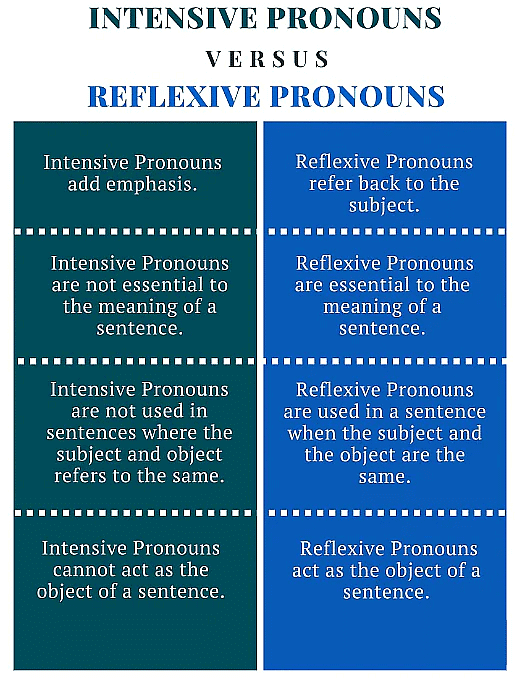
Take a look at these examples of intensive pronouns and examine how they’re different from the examples in the previous section:
- I told them I could do it myself.
- We asked ourselves, is this business really worth saving?
If you can remove a pronoun from a sentence and it loses emphasis but its meaning stays the same, it’s most likely an intensive pronoun.
Compare these two sentences:
- I built this house.
- I built this house myself.
See how the second one emphasizes that the builder had no outside help?
- Intensive pronouns can help you express pride, shock, disbelief, credulousness (or incredulousness), or any other strong emotion.
Here are a few more examples:
- They hiked the entire Appalachian Trail themselves?
- Did you, yourself, see Loretta spill the coffee?
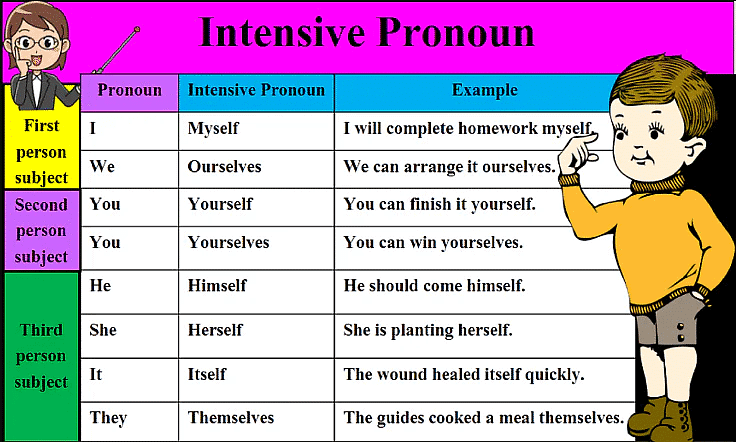
7. Possessive Pronouns
Possessive pronouns are pronouns that show possession. They include the following:
- My
- Your
- Our
- Their
- His
- Her
- Its
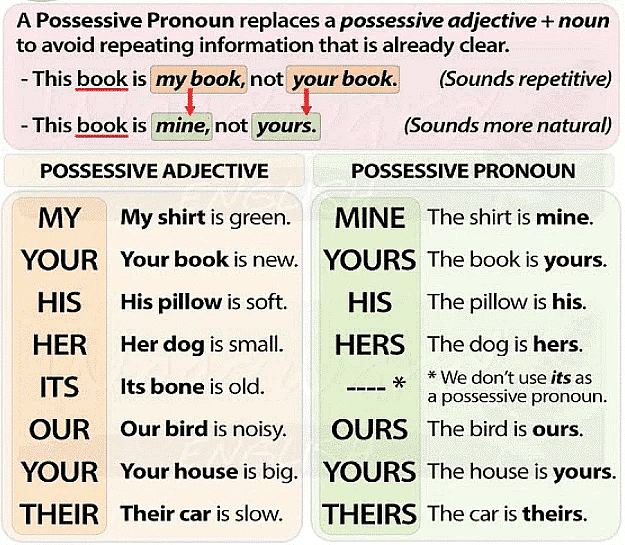
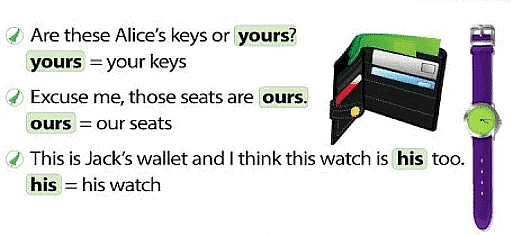
These can also be called possessive adjectives if they modify a noun in a sentence.
Take a look at these examples of possessive adjectives in action:
- I crashed my bike into a telephone pole.
- Your house is always decorated so nicely.
This category also includes independent versions of possessive pronouns. These include:
- Mine
- Yours
- Ours
- His
- Hers
- Theirs
- Its
When you use an independent possessive pronoun, you drop the noun it’s referring to.
Here are a few examples:
- She forgot her jacket, so I gave her mine.
- I had no idea whose bid won the auction, then my cousins told me theirs did.
8. Interrogative Pronouns
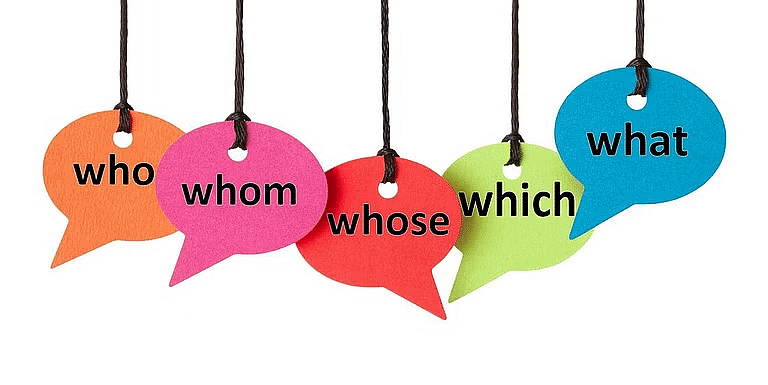
- Interrogative pronouns are used in questions.
- The interrogative pronouns are who, what, which, and whose.
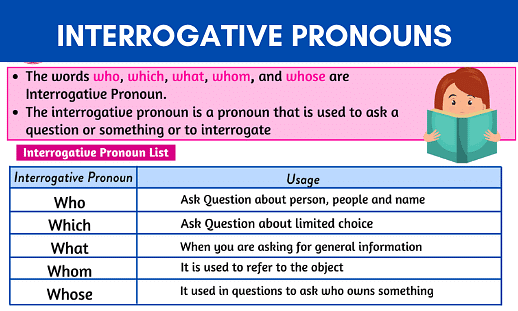
Here are a few examples of interrogative pronouns at play:
- Who wants a bag of jelly beans?
- What is your name?
- Which movie do you want to watch?
- Whose jacket is this?
9. Reciprocal Pronouns
There are only two reciprocal pronouns:
- Each other
- One another
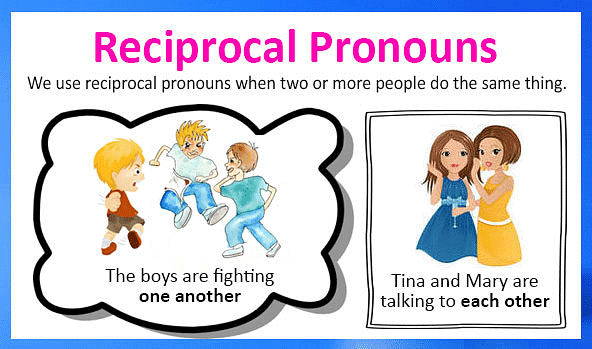
These pronouns refer to two or more people who are both the subject of the sentence.
Take a look at these examples:
- Javier and Priya, the two top salespeople on our team, are competing with each other for Salesperson of the Year.
- All my siblings are blaming one another for letting the boa constrictor out last Thanksgiving.
10. Distributive Pronouns
- Distributive pronouns refer to people, animals, and objects as individuals within larger groups.
- They enable you to single out individuals while acknowledging that they’re part of a larger group.
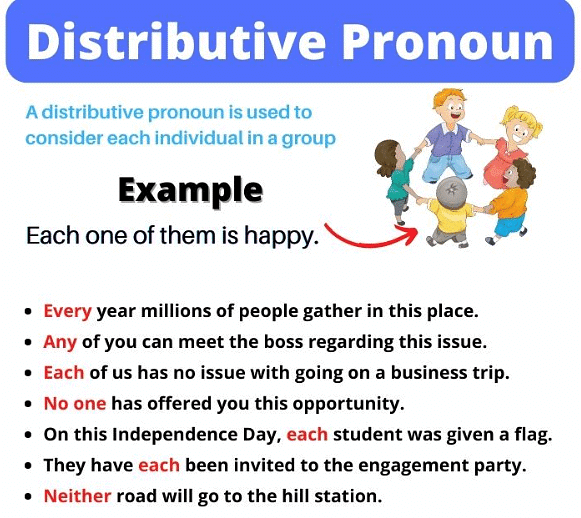
Distributive pronouns include the following:
- Either
- Each
- Neither
- Any
- None
Here are a few examples of distributive pronouns in sentences:
- All of my friends entered the costume contest and none of them won.
- Cookies and muffins are available for dessert. Neither is appealing to me.
|
20 videos|110 docs|18 tests
|
FAQs on Detailed Overview: Pronouns - English Grammar Basic - Class 10
| 1. What are pronouns? |  |
| 2. What are the types of pronouns? |  |
| 3. What is the function of pronouns in a sentence? |  |
| 4. Can you provide examples of pronouns in sentences? |  |
| 5. How can one identify the correct pronoun to use in a sentence? |  |

|
Explore Courses for Class 10 exam
|

|


















